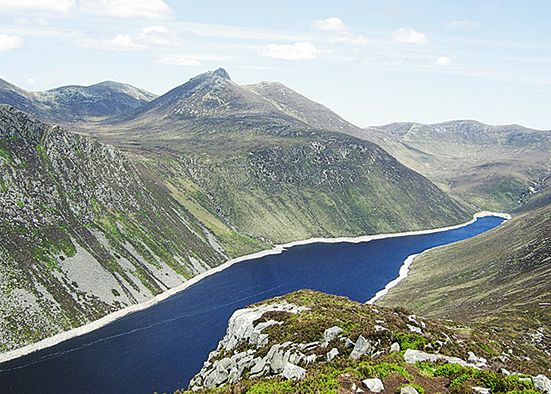How the magnificent Mournes got their name
How the magnificent Mournes got their name
14 September 2022

EVERYONE in County Down knows the Mourne Mountains. Many of us have scaled Slieve Donard or some of the other big peaks.
We’ve all marvelled at the magnificent Mourne vista while driving to Newcastle, or even from the air as we fly to, or from, one of the airports.
But how many of us know how our mountains got their name?
That story generally starts with Boirche, an ancient cowherd who roamed the area with his animals around the third century — long before sheep took over as custodians of the mountains. Boirche (pronounced ‘Borka’) was a chieftain of Ross the Red, King of Ulster, and kept the cattle on his behalf.
While the historian Dr PW Joyce wrote that Boirche’s preferred peak was Slieve Sláinge (the ancient name for Slieve Donard), more common local tradition suggests that he in fact made his stronghold among the rocky outcrops on Slieve Binnian’s summit.
There is even a ghost story that Binnian is haunted by the restless spirit of a young lady who was murdered and buried on its slopes.
She is said to appear suddenly and shoots across the open ground, supposedly blocking the path towards a clump of trees where Boirche is thought to be buried, although another common thesis is that he was buried much further to the west, near Spelga Dam and Slievenamiskan (meaning ‘Mountain of the Cairn’).
Another tale passed down the generations is that Boirche was skilled musician as well as a cowherd. He had a penchant for pipes made from elderberry trees (then known as ‘bore’ trees).
Legend has it that he had magical pipes whittled from bore trees growing by the Blue Lough, near Slieve Binnian.
One day, a raiding party landed from the Isle of Man, disguised as shepherds. They stole Boirche’s pipes but in the ensuing escape, they got stuck in Donard Bog and eventually drowned. Boirche’s pipes were retrieved and, allegedly, their music can still be heard among the hills today.
While difficult to decipher folklore from fact, there is written historical record of Boirche. The Dindshenchas (meaning ‘Lore of Places’ in ancient Irish), is a 12th century compilation of stories that explain the origins of Irish placenames. In it, the area we now know as the Mourne Mountains is referred to as ‘Beanna Boriche’ (Peaks of Boirche).
That text was not a one-off. This name can be found in a range of documents, even as late as the 17th century. Ulster Scots communities used a similar name for the mountains, calling them the ‘Borkey Bens’ (‘Ben’ means ‘mountain/hill’). This is despite there being only one ‘Ben’ in the area – Ben Crom, meaning ‘The Stooping Mountain’.
Boirche’s name even lives on today – the Irish language school in Castlewellan is called Bunscoil Bheanna Boirche.
Yet none of this explains how Beanna Boirche became The Mourne Mountains.
That transition started around the 13th century, in Monaghan and Omeath, where a clan called the Mughdorna (often translated as the MacMahons) were in control.
This clan were descended from Mughdorn, son of Colla Meann — a brother of Colla Nais, King of Ireland AD 323-326 — and their centre of power was a district known as Cremorne.
While once extremely powerful, they started to be squeezed out of their traditional lands. There are various theories that more powerful clans removed them, or that they sought refuge elsewhere after being plundered and persecuted by the invading Normans.
Either way, the McMahons migrated from Monaghan and found shelter in the mountains to the north-east, which long had a reputation for being a sanctuary that resisted forces of social and political change that affected other parts of Ireland — with St Patrick even famously refusing to set foot there on his quest to spread Christianity.
On creating their new kingdom among the mountains, the MacMahons called them Cremorne — a nod to their original homeland. Over time, this morphed into Morna, and then Mourne.
Despite the safe haven and natural protection provided by the mountains, the unravelling of the MacMahon dynasty was inevitable, especially with increasing English settlement and with their mountainous safe haven squeezed on both sides by new Norman castles at Dundrum and Greencastle.
Yet the MacMahons had the last laugh. Only the remnants of those castles remain today but the MacMahon legacy is much more longstanding and secure.
It lives on in the name of our Mourne Mountains.

